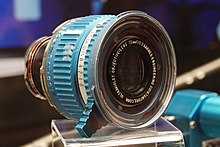Gemini 10
Jim Lovell and Buzz Aldrin had originally been named the backup crew, but after Charles Bassett and Elliot See died in a T-38 crash, they were moved to the backup crew for Gemini 9 and Alan Bean and Clifton Williams were moved to the Gemini 10 flight.
[4]: 123 Gemini 10 was designed to achieve rendezvous and docking with an Agena Target Vehicle (ATV), and EVA.
[5] This Agena's battery power had failed months earlier, and an approach and docking would demonstrate the ability to rendezvous with a passive object.
After docking with their Agena booster in low orbit, Young and Collins used it to climb temporarily to 412.4 nautical miles (763.8 km).
After the rendezvous, Collins spacewalked over to the dormant Agena at the end of a 50-foot (15 m) tether, making him the first person to meet another spacecraft in orbit.
As he was concentrating on keeping his tether clear of the Gemini and Agena, Collins' Hasselblad camera worked itself free and drifted away, so he was unable to take photographs during the spacewalk.
Film review of the Titan II ICBM launches found at least seven other instances of post-staging tank ruptures, most likely caused by flying debris, second stage engine exhaust, or structural bending.
NASA finally decided that this phenomenon did not pose any safety risk to the astronauts and took no corrective action.
However Young didn't realize that during the next burn, he had the spacecraft turned slightly, which meant that they introduced an out-of-plane error.
The crew took a couple of pictures when they reached apogee but were more interested in what was going on in the spacecraft — checking the systems and watching the radiation dosage meter.
Collins next traveled over to the Agena and tried to grab onto the docking cone but found this impossible as it was smooth and had no grip.
He decided against replacing it as a piece of shroud had come loose on the Agena which could have snared the umbilical, and returning to the Gemini was deemed the safest course of action.
[8] However, due to low propellant quantity remaining, combined with intermittent telemetry to monitor it, these fuel costly manoeuvres were abandoned and the EVA was finished after only 39 minutes.
This provided limited results due to the lack of fuel for attitude control, but found that electron and ion temperatures were higher than expected and it registered shock effects during docking and undocking.
All of these experiments were of little use as the film used was only half as sensitive as Gemini 9A and the dirty windows lowered the transmission of light by a factor of six.
The two stars have a variety of meanings: the two rendezvous attempts, Castor and Pollux in Gemini or the two crew members.
For many years the spacecraft was the centerpiece of a space exhibition at Norsk Teknisk Museum, Oslo, Norway.
This article incorporates public domain material from websites or documents of the National Aeronautics and Space Administration.




